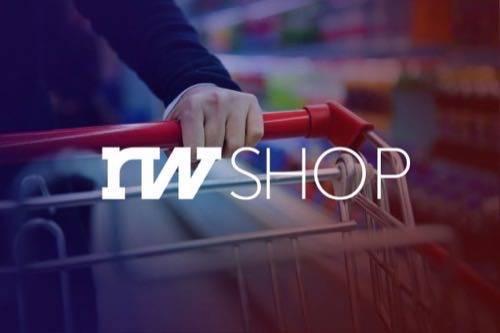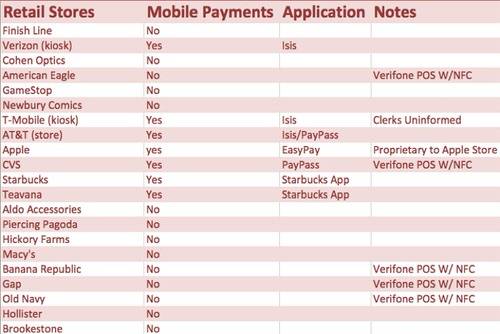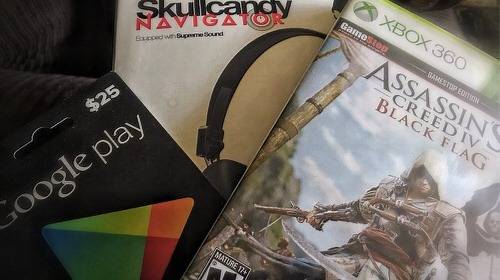
ReadWriteShop is an occasional series about the intersection of technology and commerce.
It’s Black Friday, and the Cambridgeside Galleria is, as expected, a madhouse. I don’t know why I decided coming here was a good idea. The crowd around tablets at Best Buy is three rows deep. People seem to be looking at a Kindle Fire HD, but I can’t be sure; when I try to peep over their shoulders, some lady just elbows me in the ribs. At GameStop, a kid won’t stop harassing his mother about Grand Theft Auto V, a game that is way too mature for his 10-year-old brain.
I’m on a mission to see how many places I can use my phone to pay for retail items, right here in the real world. Yes, on the busiest shopping day of the year, I’ve come to the mall to buy stuff without cards or cash.
This is what many people have in mind when they use the phrase “mobile payments”—the ability to use your phone instead of cash or plastic to pay at a store. Yes, there are lots of ways to buy stuff online via smartphone, but that’s both old news and sort of beside the point. The real end goal of mobile payments, supposedly, is to replace cash and your bloated wallet full of plastic cards.
Lots of companies claim they’re the leaders in mobile payments and that they’re gaining real traction in the brick-and-mortar world. I wanted to put these claims to the test in a real mall with merchants both large and small.
Whither A Mobile Point-Of-Sale?
Malls are the locus of American retail might, pantheons of capitalism that feature some of the largest retailers in the world. If mobile payments are ever going to take off, you’re going to have to be able to buy stuff with your smartphone at the mall.
For now, though, you mostly can’t.
I went to 21 different stores, booths and kiosks at the Cambridgeside Galleria, the biggest mall in the Boston metro area, to see if I could pay with my phone. Here are my results:

Of those 21 stores, seven accepted some type of mobile payment. Three were the cellular carriers—AT&T, Verizon and T-Mobile—that used their proprietary Isis payments app. Two others were Starbucks, which has its own payment app (it also takes Square Wallet), and Teavana, which is owned by Starbucks and can use the same app.
Outside of the carriers and Starbucks, only two stores accepted mobile payments. One was CVS, which had a brand new point-of-sale terminal that can accept a variety of payments via NFC, a short-range wireless standard. The other was Apple, which uses a process it calls EasyPay through the Apple Store App.
Just about everything else in the mall used some variety of Verifone payment terminals. Some of those Verifone systems were of the newer variety and could support NFC, but consumer would have no way to really use it. I went to ask the clerks at American Eagle, Macy’s and Banana Republic about using my phone to pay; each time I was told that I couldn’t actually do that.
“I think one customer tried to use it once, but it didn’t really work,” the clerk at Banana Republic told me. The same system is used at Old Navy and Gap. All three retail chains are owned by Gap Inc. The lady at one of the fragrance kiosks within Macy’s said that the system could scan coupons from the Internet, but wouldn’t take a payment from a smartphone.
As for the carriers, both AT&T and Verizon have little signs on their point of sale terminals that say it supports Isis. When I asked the T-Mobile representatives at the kiosk in the mall, they hardly knew what I was talking about.
The Teavana employee said that if I use the Starbucks mobile payments app, I could use it at the store. Nowhere within Teavana does it mention this fact and I had no idea that Starbucks actually owns Teavana. Considering that I don’t drink coffee but do drink a lot of tea, this would have been good information to have.
CVS had the most up-to-date point-of-sale system in the entire mall. It accepted NFC-based payments and had MasterCard PayPass integration. MasterCard is one of the top companies driving mobile payment capabilities into stores because it controls the hardware, software and what it likes to call the “transactional element”—i.e., your credit or debit card. Several other stores in the mall had terminals that could technically accept PayPass, but either the clerks didn’t know how to use it or the stores didn’t have it available (Gap and Banana Republic being the best examples here).
What’s Hindering Popular Retail Adoption?
It was easy to see what was holding back mobile payments in American retail: the lack of standards, too many competing interests, and—perhaps most important—the absence of any compelling reason to change the system, educate employees and motivate consumers to use their phones instead of plastic.
The concept of the “mobile wallet” isn’t exactly new. Google Wallet, Samsung’s wallet app, Apple Passport, MasterCard PayPass, Square Wallet, LevelUp and a long line of others want to be your “wallet” on your phone. The problem with these apps, though, is that they want to be it all. The final destination for anything that you will ever pay for. Ever.

The problem is that people’s actual wallets don’t really work like that. Nor do the stores that people buy stuff in. Each store wants to maintain its value and customer information. In many cases, they’ll do this with an app. Suppose I go shopping in the future and only carry my phone. Each retail store would have their own app that I would have to pay through. The Macy’s app, the GameStop app, the BestBuy app. What a mess.
Fundamentally, this is no different from how things work with store-issued credit cards now. At various times in my life, I’ve had credit cards issued by Macy’s and BestBuy and a GameStop membership card. They fit in my wallet and I’d haul them out when necessary. So from the merchant perspective, all that needs to change is for those “relationship” cards to live as apps on my smartphone instead of taking up space in my wallet.
Some companies have tried to make that work. Google Wallet, Square Wallet, LevelUp and the like want to be the app repository within the smartphone that fosters these transactions. But even if retailers support mobile payments—and so far, by and large, they don’t—then they’d have to agree on one standard, or support several of them.
NFC was supposed to be that standard, but retailers and customers have shown little interest in it. Increasingly, NFC looks like a technology in search of a solution.
The best hope for NFC-based transactions at the mall would be for a majority of retailers to install point-of-sale systems that support MasterCard PayPass. PayPass supports Google Wallet and could theoretically serve as a gateway for other transactional apps.
There’s Always The Internet
The bottom line: The much-talked-about mobile payments revolution in nowhere in sight. Retail stores are taking their time to updating payment-system hardware that might enable mobile transactions, and there are still too many companies and consortia vying to tie together all the other players in mobile payments—the cellular carriers, the software makers like Google, the payment processors like MasterCard and the stores themselves.
No one has much incentive to play nicely with anyone other in this space. In the end, that’s what’s stalling more widespread adoption of mobile payments. (Well, that and the fact that consumers seem unconvinced that mobile payments are worth the hassle.)
That said, this holiday season there is one place you can most certainly use your smartphone to check off your gift list: The Internet.









